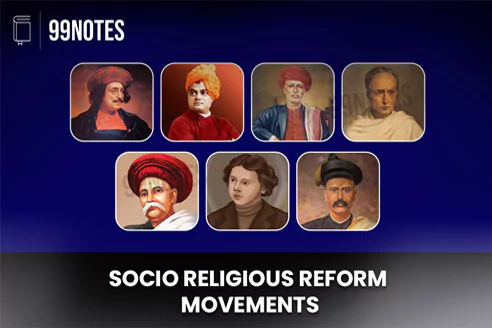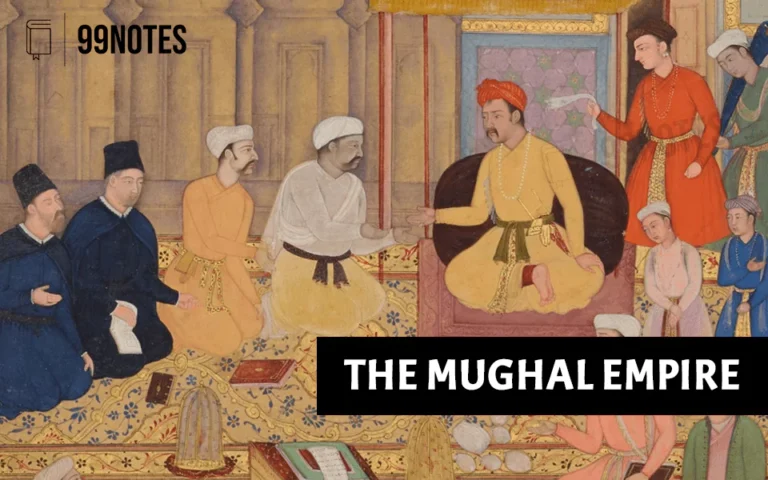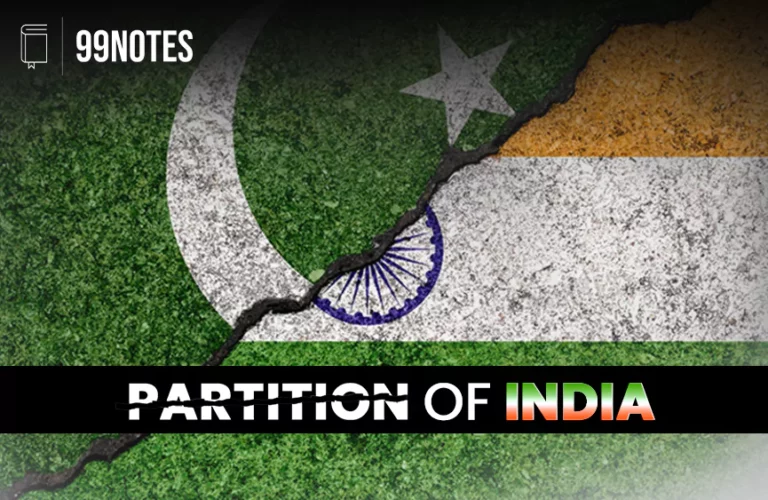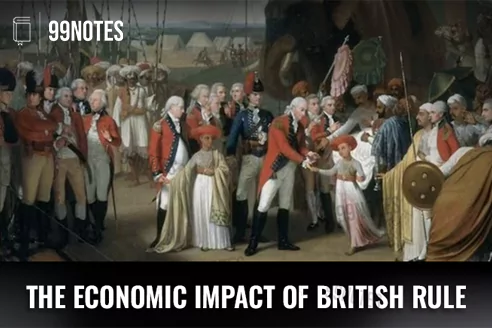Socio Religious Reform Movements- Before 1857
Socio Religious Reform Movements
The colonization of India by the British during the 18th and 19th centuries exposed some serious weaknesses and drawbacks of Indian social institutions. Consequently, several individual Socio Religious Reform movements sought to bring about changes in social and religious practices to reform and revitalize society.
They were impressed by modern science, western ideas of reason, humanism, equality, and liberty, and felt that modern Western thought must be imbibed for society’s regeneration.
Factors responsible for socio-religious reform Movements:
Various factors resulted in the need for socio-religious reforms. These are the following:
1. Impact of the British rule
- British rule brought new ideas, rationalism, and a scientific outlook. It created conditions for intellectual growth.
- The spread of Western education strongly impacted a section of Indian society.
- European Orientalists like William Jones, Max Muller, and James Princep put India’s glorious past into the limelight through their work.
- Proselytizing efforts by Christian missionaries encouraged the Indian intelligentsia to reform their society and religion.
2. Social evils prevalent in nineteenth-century India:
Indian society was facing various issues that were against humanism and human dignity. Conditions of women degraded, and caste and untouchability flourished, which affected society badly.
(I) Condition of women
- Inferior status: In a very strict patriarchal set-up, women were considered inferior to men. They were completely dependent on men, and several restrictions were imposed on them.
- Sati: Under this custom, a Hindu woman, upon the death of her husband, would sacrifice herself by sitting atop her deceased husband’s funeral pyre.
- Female infanticide: Intentional killing of a baby girl or female fetus due to the preference for a male child.
- Widow remarriage was not permitted. Women were deprived of education. They were considered ideal wives and daughters and played only domestic roles rather than public ones.
- They had no property rights. Hindu scripture has mentioned the property rights for only married women, which is only Stridhan.
- Other social evils such as child marriage, Polygamy, and Purdah (veil) were prevalent in society.
(II) Caste system and untouchability
- The four-fold division of society in the later Vedic period was further subdivided into castes and sub-castes due to racial admixture, geographical expansion, and diversification of vocations. It gradually got associated with racial purity and defined the status of different castes.
- Caste became the determinant of social and economic aspects of a person’s life, such as profession, education, ownership of property, marriage, etc.
- A section of society called Dalit or ‘untouchables’ was excluded from the four varnas and was not allowed to visit temples use public wells, etc.
(III) Priestly dominance and superstitions
- The priests who attained the highest position in society had become very exploitative by conducting elaborate rituals.
- Though rare, human sacrifices for religious and occult practices were also performed.
Socio-religious reform movements Before 1857
Various socio-religious reform movements were initiated to deal with the issues mentioned above in society. Enlightened men and women have taken various steps, like forming organizations to deal with socio-religious issues.
(I) Raja Rammohan Rai (1772-1833) and Brahmo Samaj
- He is considered the father of the Indian Renaissance.
- He tried to incorporate both Western and Eastern philosophies in his works.
- He was a great scholar of Persian, Sanskrit, and several other European languages. He wrote Tufat-ul-Muwahiddin in Persian.
- He was a strong proponent of English education, including Western physical and social sciences.
- In 1825, Rajaram Mohan Roy established Vedanta College, where courses in both Indian and Western learning were offered.
Efforts with respect to the upliftment of women:
-
- His efforts against the practice of Sati were rewarded by passing the Bengal sati regulation in 1829, which banned the practice of Sati. In this endeavor, he appealed to the masses’ reason and compassions and showed that even ancient Hindu texts did not authorize this practice. He even called it “murder according to every Shastra.”
- He advocated against Polygamy and supported girl education and property rights for women.
Religious Views and Reforms
-
- He believed in monotheism and opined that all the principal ancient texts of the Hindus preached monotheism or worship of one God.
- In his book Precepts of Jesus, he criticized ritualism in Christianity.
In 1814, he established the Atmiya Sabha to propagate Vedanta’s monotheistic ideals and campaign against idolatry, caste rigidities, and meaningless rituals.
Brahmo Samaj
- Raja Rammohan Rai founded the Brahmo Sabha in 1828; it was later renamed Brahmo
- It believed in the monotheistic ideas of the Upanishad and denounced polytheism and all forms of idolatry and sacrifice.
- It criticized the caste system. It was against the hierarchy of the people based on birth. It also left the question of Karma doctrine to the individual followers.
(II) Debendranath Tagore (1840s)
- He headed the Tattvabodhini Sabha (1839), which propagated the ideas of Raja Rammohan Rai.
- He gave a new life to Brahmo Samaj when he joined it in 1842.
- Later, the Tattvabodhini Sabha was merged with the Brahmo Samaj.
- It opposed the attempts by the Christian missionaries to criticize Hinduism and convert people to Christianity.
(III) Role of Keshab Chandra Sen in Brahmo Samaj (1838-84)
- He brought new energy to the movement and was instrumental in popularising it. During his leadership, the movement was expanded, and branches of the Samaj were opened outside Bengal.
- However, Debendranath Tagore found some of Sen’s ideas to be ‘too radical,’ especially including teachings from various religions in the Sabha meetings, strong views on the caste system, and open support for inter-caste marriage.
- He was removed from the office of Acharya and founded Brahmo Samaj of India in 1866. Debendranath’s Brahmo Samaj was known as Adi Brahmo Samaj.
- In 1878, Keshab Chandra Sen married his thirteen-year-old daughter to the Maharaja of Cooch-Behar with orthodox Hindu rituals. This caused a split in the Sabha, and the disgusted followers of Keshab Chandra, led by Anandmohan Bose, set up a new organization called Sadharan Brahmo Samaj.
Other Socio-religious reform movements:
| Young Bengal movement and Henry Vivian Derozio
(1809-31)
|
● Henry Vivian, an Anglo-Indian, was a teacher at the Hindu College.
● He was influenced by the French Revolution and inspired his students to question all authority, to think freely and rationally, , and teach them the ideas of liberty, equality, and freedom. ● His movement supported women’s rights and education. ● They also demanded the induction of Indians into higher grades of service, protection of peasants from the exploitative Zamindars, freedom of the press, trial by jury, etc. ● However, they lacked any real link with the masses because his ideas were radical and the social situation was not ripe. ● Later, Surendranath Banerjee described the Derozians as “the pioneers of modern civilization of Bengal. |
| Ishwar Chandra Vidyasagar
(1820-91) |
● He was a great scholar and reformer; his ideas were a blend of both Indian and Western thoughts.
● He opened schools for non-Brahmins to break the priestly monopoly of scriptural knowledge. ● He introduced Western thoughts to the Sanskrit school to break the self-imposed isolation of Sanskrit learning. ● He started a movement in support of widow remarriage, which played an important role in legalizing it (Hindu Widow Remarriage Act, 1856). ● He also raised his voice against Polygamy and child marriage. ● As a secretary of Bethune School, he played an important role in the cause of women’s education. ● Contribution as a writer: He contributed significantly towards the simplification and modernization of the Bengali language; for that, he earned the title of “father of Bengali prose.” His literary works include Borno Parichay, Banglar Itihas, Bengali translation of Kalidasa’s Shakuntala, etc. |
| Balshastri Jambekar
(1812-46)
|
● He used Journalism as a tool to bring about social reform.
● He is known as the father of Marathi journalism; he started the newspaper Darpan in 1832. ● He started Digdarshan in 1840, which published articles on scientific subjects and History. ● He attacked Brahmanical orthodoxy and tried to revive popular Hinduism. |
| Paramahansa Mandali
|
● It was founded in Maharashtra in 1849 by Dadoba Pandurang and Mehtaji Durgaram.
● It was closely related to Manav Dharm Sabha. ● It began as a secret society to reform society as well as Hinduism. ● They believed in the worship of one God, and according to them, real religion is based on love and moral conduct. ● They encouraged freedom of thought and rationality. ● They were primarily focused on breaking caste rules, and food cooked by lower caste people was served at their meetings. |
| Wahabi/Walliullah Movement
|
● It was a revivalist response to the Western influence and degeneration of the Indian Muslims.
● The teachings of Abdul Wahab of Arabia and Shah Walliullah (1702-63) inspired this movement. ● He called for a return to the true spirits of Islam. ● The teachings of Walliullah were further popularised by Shah Abdul Aziz and Shah Ahmed Barelvi; they gave it a political perspective. ● India was considered as Dar-ul-Harb (land of the Kafirs). It is needed to be converted to Dar-ul-Islam (land of Islam). ● Initially, it was directed against the Sikhs (Battle of Balakot), but with the annexation of Punjab, it was directed against the British. |
| Titu Mir’s movement
|
● Titu Mir (Mir Nithar Ali) was Sayyid Ahmed Barelvi’s disciple and the Wahabi movement’s main proponent.
● He advocated for Sharia law. ● He organized Muslim peasants of Bengal against landlords, who were mostly Hindus and Indigo planters. |
| Faraizi Movement
|
● It was founded by Hazi Shariatullah in 1818.
● It aimed at eradicating un-Islamic practices prevalent among the Muslims of East Bengal. ● Under Dudu Miyan, Hazi’s son, the movement became revolutionary from 1840 onwards. ● The Faraizis organized a paramilitary force against zamindars, who were mostly Hindus. |
| The Pagalpanthis
|
● It was a semi-religious body mainly consisting of the Hajong and Garo tribes, founded by Karam Shah.
● Pagal Panthis were primarily nature worshippers; later, they incorporated elements of all religions and were consistent with the traditional faiths of the peasantry. ● Under Tipu Shah, son of Karam Shah, the movement adopted the character of a peasant movement. |
Assessment of the socio-religious reform movements in the 19th century
These Socio-religious reform movements have been viewed by various scholars from different perspectives.
- The socio-religious reform movements stood for the democratization of society, the removal of superstition and abhorrent customs, the spread of enlightenment, and the development of a rational and modem outlook.
- They gave a vision of a prosperous and progressive modern India, subsequently incorporated into the Indian National Movement.
However, these movements had several limitations too:
- Socio-religious reform movements had a very narrow social base, mostly among the educated and the urban middle class. They failed to make a difference in the lives of the general masses, peasants, workers, etc.
- They mostly relied on scriptural authority and its interpretation and shied away from experimenting with modern ideas separate from religion.
- Failed to perceive the political aspect: The social reformers perceived the social, religious, and cultural aspects of the society accurately, but they failed to perceive the political aspect of the exploitative British rule. The British supported leaders like Raja Ram Mohan Roy and Ishwar Chandra Vidyasagar.
- Disfavour from the British government: The British, till 1857, favored socio-religious reforms; however, after the revolt, they did not want to antagonize the orthodox elements of the society, so they were no longer interested in the reform process.
Despite some issues faced by the socio-religious reform movements, their contributions cannot be neglected as they had a wide impact on society. These movements founded the basis of the society based on rationalism and humanism. This enlightened society and contributed to the formation of nationalism in the long run.





![Fundamental Rights Of Indian Constitution: Article12-35 [Indian Polity Notes For Upsc Exams] | Updated July 27, 2024 Fundamental Rights Of Indian Constitution: Article12-35 [Indian Polity Notes For Upsc Exams]](https://99notes.in/wp-content/uploads/2023/09/fundamental-rights-banner-99notes-651fdb2e2cee1.webp)

